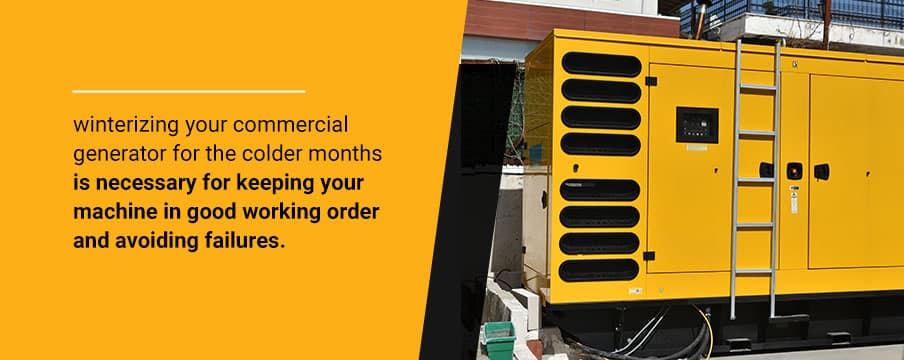9 Ways to Extend the Life Expectancy of Your Diesel Generator

When it comes to many different industries, industrial generators in both diesel and natural gas configurations play a critical role in providing power when it’s needed most. Backup generators are not solely used in industrial sectors, but are often used in agriculture, data centers, municipalities, manufacturing plants, processing facilities, construction, and even hospitality among many others. For many companies, these pieces of machinery may be a major investment that will be heavily depended on for many years. In order to maximize the life of your backup generator, you can take some preventative measures to help extend generator’s life span longer while keeping it running at its best.
See how a little can go a long way in extending the life of your backup generator so your company will be ready for whatever life throws at you.
How Long Does a Commercial Generator Last?
A generator’s life span depends on multiple variables. As long as the machine is exercised and well maintained, it can generally last upward of 30,000 hours. However, without proper care and attention, a generator could wear out around 10,000 hours or much fewer.
We must note that typically, a diesel generator’s life expectancy is longer than that of a natural gas generator, but diesel options take some additional effort to ensure they are running smoothly. A few factors contribute to generator life expectancy, including:
- The brand and level of quality.
- Generator sizing.
- Regular maintenance.
- The age of components and parts.
- The engine size.
- How it was installed.
- The surrounding environment.
- Quality of fuel used.
Understanding your generator’s needs and targeting your maintenance efforts to fit these considerations can help you keep your generator up and running. While there is no concrete number of hours that these machines will work for, it’s always good to find out approximately how many hours a diesel generator may last so you’ll be prepared to meet your company’s power needs in cases where you may need to service or upgrade your existing generator.
How to Extend Your Diesel Generator’s Life Expectancy
To reap all the benefits of investing in a diesel generator, you will need to know how to best care for and maintain it so that it works when it’s needed. Here are nine ways to elongate your industrial generator’s life expectancy:
1. Have the Oil Levels Checked Regularly
Regularly checking and changing the oil in your generator will help you ensure it is functioning optimally. Without a sufficient amount of oil, the moving parts will not be lubricated enough to avoid damage when contact occurs. Newer generators will shut off if they have insufficient oil levels.
Make it a routine to check your oil levels every few weeks or so. You’ll need to pull out the dipstick when inspecting them. If the levels are low and the oil looks clean, your generator simply needs more oil. If the dipstick comes out with low, dirty oil levels, the oil needs changing.
2. Use High-Quality Fluids
A diesel generator will run best with high-quality fluids. These substances include everything from the oil to the coolants used. Low-quality fuel, for example, can cause a myriad of issues like clogging and buildup in a carburetor. If a carburetor is dirty for too long, it will need replacing entirely.
The fuel grade used for a generator impacts how effectively the machine runs. Combat unnecessary contaminants and buildup that interfere with a generator’s performance by choosing high-quality fluids and testing the fuel regularly to ensure it is not degrading.
3. Conduct Load Bank Testing Regularly
To see how efficiently your generator is operating, you will need to conduct load bank testing regularly. This testing is part of preventative maintenance and allows technicians to see if a generator is operating optimally. Because standby generators are not used regularly, testing is necessary to ensure their ability to run effectively.
During a load bank test, an artificial load brings the engine to a certain internal pressure and operating temperature. The test exercises the generator to make sure it can run at its given kilowatt output. Load bank testing benefits your generator by removing carbon buildup from the engine, verifying electrical connections and more. Load bank tests are also a good indicator to see if there may be any potentially failing components to your generator or items that need to be addressed during routine service & maintenance.
When it comes to diesel generators, load bank tests also help prevent wet stacking which can damage a generator set and render is inoperable and possibly even irreparable. We’ll cover wet stacking more in the next section.
4. Avoid Wet Stacking
Wet stacking prevention is crucial for the longevity of any generator. Wet stacking refers to the phenomenon when unburned fuel leaks into the exhaust pipes of diesel engines, leaving a dark, thick substance behind.
Wet stacking occurs when you run a diesel generator by:
- Operating it at under 60% of its rate power load.
- Working with the wrong air-fuel ratio.
- Using the generator too much or not often enough.
- Operating it at the wrong temperatures.
Experts suggest examining your generator for wet stacking at least once per month and taking preventative steps to avoid this problem altogether such as conducting regular load bank tests to exercise the generator.
5. Perform Regular Preventative Maintenance
The trick to getting diesel engines to work for long periods is performing regular preventative maintenance to ensure everything works as intended.

For optimal functioning, a generator should receive routine service. Every week or so, check the oil and coolant levels. Every six to 12 months, a generator professional should conduct a detailed inspection.
6. Follow the Manufacturer’s Instructions
When it comes to making the most of your commercial generator, follow the instructions given by your generator’s manufacturer for guidance on the following:
- Installation practices
- Load size
- Maintenance
- Fuel type
- Frequency
- Exercise
The manufacturer’s instructions will help you take the best possible care of your generator so it will continue functioning when needed for the longest length of time. This is especially important, since there are general service & maintenance guidelines for generators, but certain manufacturers may have more specific guidelines when it comes to keeping your generator in tip-top shape.
7. Keep the System in the Right Location
For an industrial generator to function at its best, it needs to be kept in the right location — meaning it should be away from:
- Doors.
- Windows.
- Air vents.
- Anything flammable.
- High-traffic areas.
Shelter your generator with a properly fitted outdoor cover that prevents water, dirt and dust from getting in the engine. This addition will help reduce fuel degradation that causes various engine problems, from filter plugging to increased fuel burning.
If your generator is installed indoors, be sure to have the venting system inspected regularly to ensure that there will be no issues with the exhaust systems to keep the work environment safe.
Portable generators might be convenient due to being trailer mounted. This portability enables users to move the generator from location to location across a work site or facility. While it may be convenient, just like stationary backup generators – it’s important to keep this generator away from air vents, windows, doors, and high-traffic areas due to the exhaust that is emitted when operating to maintain a safe working environment.
8. Prioritize Clean Air
Part of storing a generator in the proper area is prioritizing clean air. Because the engine works by compressing air and injecting it into the fuel supply, air quality matters. Dust and debris can clog air filters, which impedes the generator’s ability to function properly. Clean and replace the air filters regularly to promote better circulation.
9. Prep Your Generator for Winter
For optimal functioning, a generator should receive routine service. Every week or so, check the oil and coolant levels. Every six to 12 months, a generator professional should conduct a detailed inspection.

With winter comes low temperatures and severe weather like ice storms and blizzards. Preparing and winterizing your commercial generator for the colder months is necessary for keeping your machine in good working order and avoiding failures.
Make sure your generator is ready for possible power outages and interruptions by doing the following:
- Change the oil
- Test the batteries
- Use a water jacket heater
- Check on exhaust pipes
- See if the manufacturer has winter guidelines
- Check all exhaust and vent covers – snow & ice can cause buildup, which can reduce or even impair performance
Elongate Your Generator’s Life With Woodstock Power Company
Lengthening your generator’s life will save time and money and prevent the headaches that come with not having a reliable backup power source. Diesel generators require special attention to be ready when you need them. From financing to load bank testing, Woodstock Power Company provides generator sales and services that will leave you feeling confident your generator is prepared for whatever life brings.
Interested in our comprehensive generator services? Contact Woodstock Power Company by calling us at 610-658-3242.

